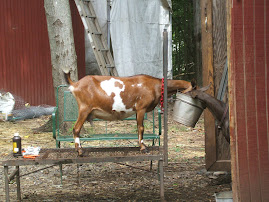Cheese is made when milk separates into curds and whey. But how do you get a liquid to become solid? Yes, I know you can freeze a liquid to make a solid but that would not work if you are trying to make cheese. Milk can be coagulated many different ways, some of which are simple and others confusing
Milk can be coagulated by the addition of acid such as lemon juice, vinegar, or citric acid. This raises the PH of the milk and causes small, soft curds to form. Acidification can be used to make fresh cheese that included heating the curd. This is how lemon cheese, Ricotta, and paneer are made. These are very simple quick cheeses which anyone can make at home.
Time can coagulate milk and will create a product know as Bonny Clabber. Bonny Clabber is sour raw milk that is thickly curdled and comes from the Gaelic words bainne which means milk and claba which means thick. It is similar to yogurt or Quark and has a sour flavor. This is a traditional food enjoyed in the American South as well as Scotland and Ireland. But time will not produce a strong curd for making hard or aged cheeses. If you want to make cheddar you need rennet.
Rennet is a complex enzyme that occurs naturally in baby animals to aid the digestion of mother’s milk. It can be made from calves, lambs, or kids while they are only consuming milk. Calf rennet comes from the fourth stomach, which is known as the abomasums. Rennet contains chymosin and lipase as well as other enzymes. Animal rennet is 90% pure chymosin. Rennet breaks down the kappa casein protein which keeps milk in liquid form.
Animal rennet is preferred for making aged cheeses because its additional compounds can further breakdown proteins. Some people think it is cruel but I see it as using the whole animal. The animal is not killed only for its stomach. Rennet production is a natural by-product from veal production. It is also a traditional way to make cheese which I find very comforting. A cheese like Roquefort which has been made that same way for centuries could never be made with anything but animal rennet.
But let us explore the varieties of “rennet” which are being used to make cheese. This is where confusion comes into play as some of these terms are used interchangeable.
Microbial rennet is often called Vegetable rennet or Vegetarian rennet. Microbial rennet is made by fermenting fungus, bacteria, or yeast. Fungi often used are Mucor miehe, Mucor Pusillus, and Endothia cryphonectria and common bacteria are Bacillus subililis and Bacillus prodigiosum. There is no mold contained in the final product. It works as well as animal rennet but can have a bitter taste when used in cheeses that are aged over six months and does not always produce the firmest curd. Microbial rennet is suitable for vegetarians but it is not true vegetable rennet.
True vegetable rennet is made from plants such as fig tree bark, cardoon thistle, mallow, Ground Ivy, nettle and even pineapple and papaya. They can be unpredictable and bitter and there is no industrial production of vegetable rennet. If you want true vegetable rennet you must make it yourself. I have experimented with nettle and fig bark with no success. Some cheeses made cardoon thistle include Cardo from the UK, Serpa DOP from Portugal, and Caciofiore from Italy. These cheeses can range from soft and creamy to hard and aged.
The newest coagulating option is fermentation produced Chymosin Rennet also know as microbial chymosin which is made by removing the rennet producing gene from an animal cell’s DNA and then inserting it into the bacteria, mold, or yeast cell’s DNA. This will force the host to produce the chymosin enzyme which is then cultivated and fermented. It can be made cheaply and in an unlimited supply. It also does not have the bitterness often associated with microbial rennet. This is seen as a vegetarian friendly option but is derived from animals. The downside is that it is made from Genetically Modified Organisms, GMO.
In 1989, microbial chymosin was recognized by the FDA as Generally Regarded As Safe or GRAS. After a 28 month review, the FDA approved the first genetically engineered product for human consumption with the approval of microbial chymosin. It is estimated that between 70-90% of cheese produced in the United States is made with bioengineered chymosin. I personally try to avoid anything that is GMO because I do not trust its safety. But it can be hard to tell what exactly is in cheese.
The FDA does not require cheesemakers to label their cheese with the type of rennet used during production. Labels will often say “enzymes” which could include rennet made from animal, plant, microbial, or genetically engineered. They do not need to label their cheese as GMO when Fermentation produced Chymosin Rennet or microbial chymosin is used.
There are some great cheese producers in America that are happy to tell you they use vegetarian enzymes or rennet such as Cypress Grove and Cowgirl Creamery. But few seem willing to admit to the use of GMO rennet. I had no idea about GMO rennet until I researched this article. I would like to know who is using the stuff if upwards of 90% of cheeses made in the United States use microbial chymosin. Why label an item if you are going to be vague about it?
Wednesday, May 5, 2010
Subscribe to:
Comments (Atom)























